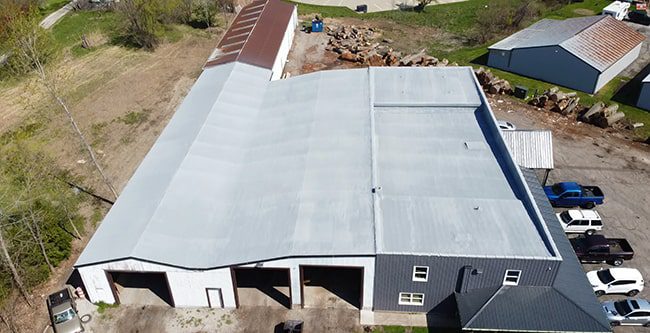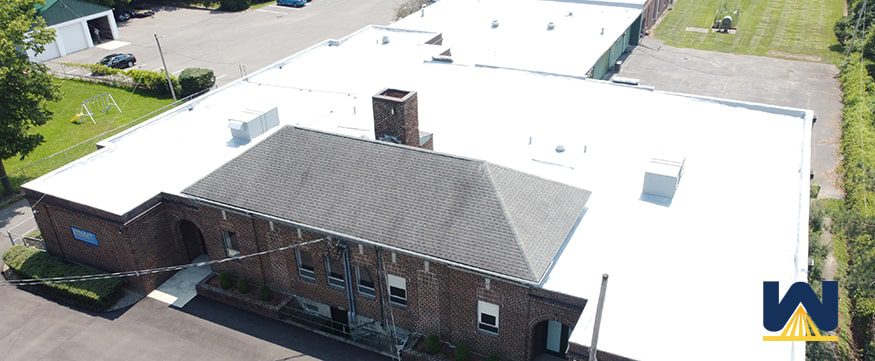I recently got an unexpected call from a commercial property owner. They said that they had a spray foam roof installed in 1994, it’s been recoated twice, but now there’s some leaking.
They want to know if it’s more cost-effective to perform another recoat, or start over and install a new roofing system, such as TPO.
Cost is their number one priority.
But what other pros and cons are there based on which way they choose?
In short:
Pros of staying with a spray foam recoat
- More cost-effective on initial installation
- More cost-effective long-term
Cons of staying with a spray foam recoat
- Need to be careful about which roofing company you choose (as the last one went out of business)
Pros of switching to TPO
- You get to start fresh
- Lots of contractors to choose from
Cons of switching to TPO
- Costs are higher on initial installation
- Lifetime costs will be higher than spray foam
If that’s all the info you were after…great. If you want a more detailed answer, please continue reading.
In this article, you’ll learn:
- The cost of installation going with spray foam
- The cost of installation going with TPO
- Future costs of spray foam and TPO roofing systems
And just so you’re aware, we only write articles based on true events and experiences. Every piece of content written at West Roofing Systems is produced in-house. Every article is reviewed and edited by a roofer/salesman with more than 30+ years of experience in the field.
West Roofing Systems has been in commercial roofing since 1979.
Let’s get started!
The cost of installation going with spray foam or TPO
To determine the cost, the first step is to perform an inspection of the existing spray foam roof. An infrared survey can also be used to determine if there’s any saturation in or below the roof’s membrane.
No matter which roofing system you’d like to install, all saturated areas need to be removed and replaced before the installation of a new roofing system.
The more areas that need to be removed and replaced, the higher the cost will be.
Going back to the unexpected caller…after a roof survey and infrared inspection were performed, the roof was in decent shape and only needed a few small repairs to make the roof watertight.
Now that the roof is watertight, what are the costs to install each system?
Install spray foam over an existing spray foam roof
Because the existing roof is spray foam, all a contractor needs to do is remove any foam that’s in bad shape.
This is done through removal or scarfing (which is similar to a lawnmower), then cleaning the roof and installing new foam and coating.
Depending on how much foam needs to be added and the length of warranty the building owner would like, can make the cost go up or down.
Let’s say the roof is 10,000 sq. ft. and 5% of the roof needed new foam. Then a contractor would add new coating over the entire roof.
Let’s say the building owner would like a 10-year warranty.
An estimated range would be $3 – $4 per square foot, which would bring the cost to $30,000 – $40,000.

Install TPO over an existing spray foam roof
Since the existing roof is spray foam, and that we’ve determined that the current foam roof is in decent shape, a contractor would have to install a cover board or insulation board before installing TPO.
Installing a new TPO roof with a cover board has a wide cost range, from $3.50 to $7.50 per square foot.
Variables include:
- How many penetrations does the roof have? Since TPO is rolled out in large sheets, these need to be custom cut to fit around penetrations. The more penetrations, the more costly a TPO installation can be.
- How thick of TPO are you installing? TPO comes in 45, 60, and 80 mil thicknesses. The thicker the product, the higher the cost.
- Does the roof need to be tapered? Tapered is another way to say slope. Since TPO is a flat sheet, the slope is created with the insulation boards. If extensive sloping is needed, it can add a significant amount of cost to the project.
Back to the unexpected caller.
It’s likely that in 1994, spray foam wasn’t the original roof. Spray foam was likely installed over another roofing system, such as modified bitumen or a gravel built-up.
This means that two roofing systems are already installed.
Per building code, two is the maximum number of roofing systems installed on a commercial building.
The existing spray foam roof would need to be removed and transported to a landfill to install the TPO roof.
It will likely cost at least a minimum of $6 per square foot to remove and install any roofing system.
If the roof is 10,000 square feet, the cost at a minimum would be $60,000.
Future costs of spray foam and TPO roofing systems
There are a few things that you might want to consider about each roofing system.
- The R-value
- What can happen after the roof’s lifespan is complete
R-value
R-value is a measurement of a material’s ability to withstand the transfer of hot and cold air. The higher the R-value, the more resistance against heat and cold air transfer that material has.
In general, the more R-value your roof has, the lower your energy costs will be.
Spray foam has an R-value of 6.5 per inch of thickness. This is higher than any other roofing insulation available.
Now…a TPO roof that uses polyiso board can obtain the same R-value as spray polyurethane foam, but it will be more expensive.
What can happen after the roof’s lifespan is complete
If cost is important to you, looking at the lifetime cost of a roofing system is something you should consider.
After 20 years, what will happen to the roof?
On traditional roofing systems, such as TPO, when their service life is over, they cannot be renewed. In most cases, they will need to be completely removed and replaced with a new system.
As stated before, a complete tear-off and the installation of a new roofing system will cost a minimum of $6 per square foot.
A spray foam roof can be renewed once its service life is over.
It’s called a recoat. This simply means the roof is cleaned and more coating is installed.
For a 20-year warranty spray foam roof, 30 mils of coating will be installed. After 20 years, the 30 mils of coating will naturally wear down to around 7-8 mils.
In year 20, a contractor cleans the roof and brings the level of coating back to 30 mils.
A new 20-year warranty would be granted.
The spray foam underneath the coating doesn’t lose any R-value or waterproofing properties.
A spray foam recoat costs between $2 and $4 per square foot.
What are your next steps if you’re considering TPO over your spray foam roof?
The first step is to contact a spray foam roofing contractor. They need to determine the overall condition of the spray foam roof to see if it’s worth repairing and recoating.
Then ask the spray foam contractor for a quote for a recoat and a new warranty.
Then contact a TPO manufacturer and have them give you a quote.
Once you have those two numbers, you can decide which is the better cost-effective option.


